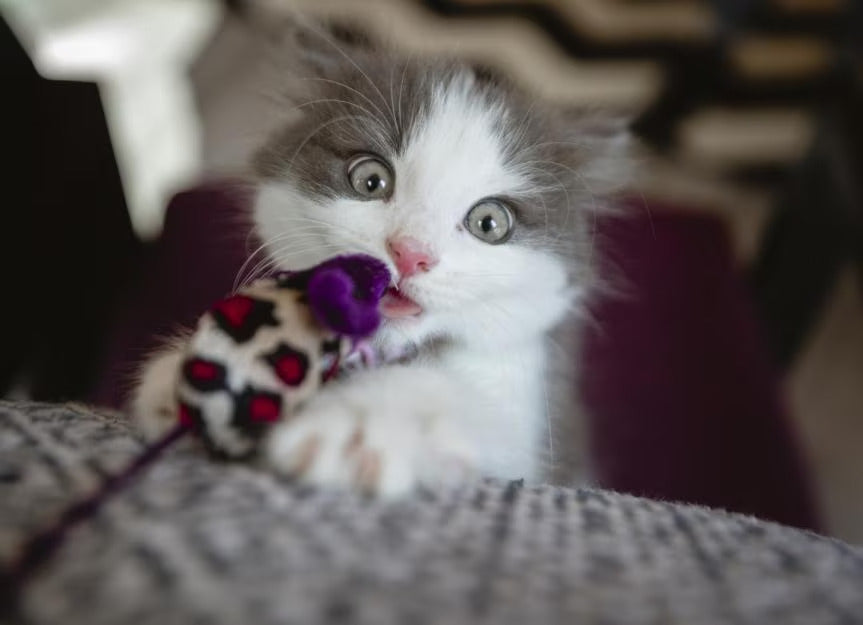
Kittens go through two periods of teething—the first when their deciduous (baby) teeth come in, and the second when their baby teeth fall out and are replaced by their permanent (adult) teeth.
You may have already seen some of the signs of kitten teething. Knowing what to expect and how to handle kitten teething can make the process easier for everyone.
Do Kittens Have Teeth at Birth?
When kittens are born, they have no teeth because they don’t need them when their sole source of nutrition is their mother’s milk. But kittens grow up fast! Soon they’ll be weaned and need teeth.
Their jaws are still too small for adult teeth, which is why young kittens first develop a smaller set of baby teeth. As they get bigger, these baby teeth fall out to make room for their larger set of adult teeth.
Kitten Teething Timeline
This timeline details important kitten teething milestones, from birth to a full set of adult cat teeth. Keep in mind that some variation can be normal. Talk to your veterinarian if you have any questions or concerns.
Baby Teeth
-
Birth – Kittens are born with no teeth.
-
2 to 4 weeks – A kitten’s incisors erupt. These are the tiny teeth at the front of the upper and lower jaw. There will be six on the top and six on the bottom.
-
3 to 4 weeks – A kitten’s canines (the long teeth just to the outside of the incisors) come in. Kittens have four canines, one on each side of the top jaw and one on each side of the bottom jaw.
-
4 to 6 weeks – The last baby teeth to erupt are a kitten’s premolars. Kittens have three premolars on each side of their upper jaw, and two premolars on each side of their lower jaw.
-
8 weeks – All 26 of a kitten’s baby teeth are usually in by the time they are 8 weeks old.
Kitten Teeth and Adult Cat Teeth
Kittens have 26 baby teeth—12 incisors, four canines, and 10 premolars (six on the top jaw and four on the bottom jaw). After their permanent teeth have come in, they will have 30—12 incisors, four canines, 10 premolars, and four molars.
Baby teeth are smaller and sharper than permanent teeth. They can also be more translucent than adult cat teeth.
Adult Cat Teeth Timeline
-
3 ½ to 4 months – A kitten’s baby incisors start to fall out and are replaced by adult incisors.
-
4 to 5 months – The baby canines and premolars start to fall out. Adult canines, premolars, and one molar on each side of the upper and lower jaws start to erupt.
-
5 to 7 months – By around 6 months of age, a kitten will have their full set of 30 adult teeth.
Signs That Your Kitten Is Teething
You may notice that your kitten is teething by seeing new teeth erupt or even finding baby teeth around the house, although kittens usually swallow them. Behavioral changes like the following are also common when a kitten is teething:
-
Showing signs of discomfort: Teething is painful, so a kitten may paw or rub at their face or just be crankier than normal.
-
Having difficulty eating: Chewing on hard food can hurt during teething, so a kitten may be reluctant to eat, or even drop food from their mouth.
-
Drooling: Just like human infants, kittens can drool when they are teething.
-
Bad breath: The characteristic “kitten breath” smell is associated with teething.
-
A desire to chew: Chewing on soft objects can soothe irritated gums.
Toys for Kitten Teething
Many kittens will want to chew on things when they are teething. This is a normal and beneficial behavior, so don’t try to stop it. Instead, you can redirect it toward appropriate things.
Don’t let your kitten chew on your hands, as this can be a hard habit to break! Keep your kitten from chewing potentially dangerous household objects. Instead, provide them with lots of soft kitten chew toys like the Petstages Dental Kitty Chew Wheel Cat Chew Toy and KONG Nibble Carrots.
A frozen washcloth is a good quick fix for a teething kitten who needs to chew. Simply freeze a damp, clean washcloth until it is “crunchy.” The combination of the frozen washcloth’s texture and temperature is ideal for teething kittens.
What’s the Best Food for Teething Kittens?
Most kittens continue to eat well throughout the teething process, even when they are fed dry food. But if your kitten seems to be struggling, a switch to wet food should help.
There are other benefits to making the switch from dry to wet food as well. Wet food is generally healthier for kittens and cats. It contains fewer carbohydrates than dry food and more protein and water, which better matches feline nutritional needs. If your kitten thrives on wet food, consider making the switch permanent.
Brushing a Kitten’s Teeth
Use your kitten’s teething period as a time to train them to accept toothbrushing rather than trying to rigorously brush their teeth. Their mouth may be tender, and you don’t want them to associate toothbrushing with pain.
Instead, use a soft finger brush and a little bit of tasty cat toothpaste to gently massage their teeth and gums. This will feel good and get them ready for more thorough toothbrushing sessions once all their adult teeth come in.
When Do Kittens Need to See a Vet for a Dental Appointment?
Kittens need to see a veterinarian for general preventive care every 3-4 weeks, starting when they are 6-8 weeks old and ending when they are 16-18 weeks old. The doctor will examine their mouth and teeth as part of a physical exam at each of these visits, as well as at all subsequent wellness visits when they are adult cats.
But it’s also important to keep an eye on your kitten’s development at home, because problems can show up between vet visits.
For example, a baby tooth should fall out before its corresponding adult tooth emerges. When this doesn’t happen, a kitten is said to have persistent or retained deciduous teeth, which can lead to tooth crowding, abnormal tooth eruption, periodontal disease, wounds in the mouth, or infection. Promptly removing persistent deciduous teeth will allow a kitten’s adult teeth to come in normally.
Talk to your veterinarian if you have concerns about your kitten’s teeth. They can recommend appropriate treatment options for dental problems and help your kitten grow into a healthy and happy adult.

